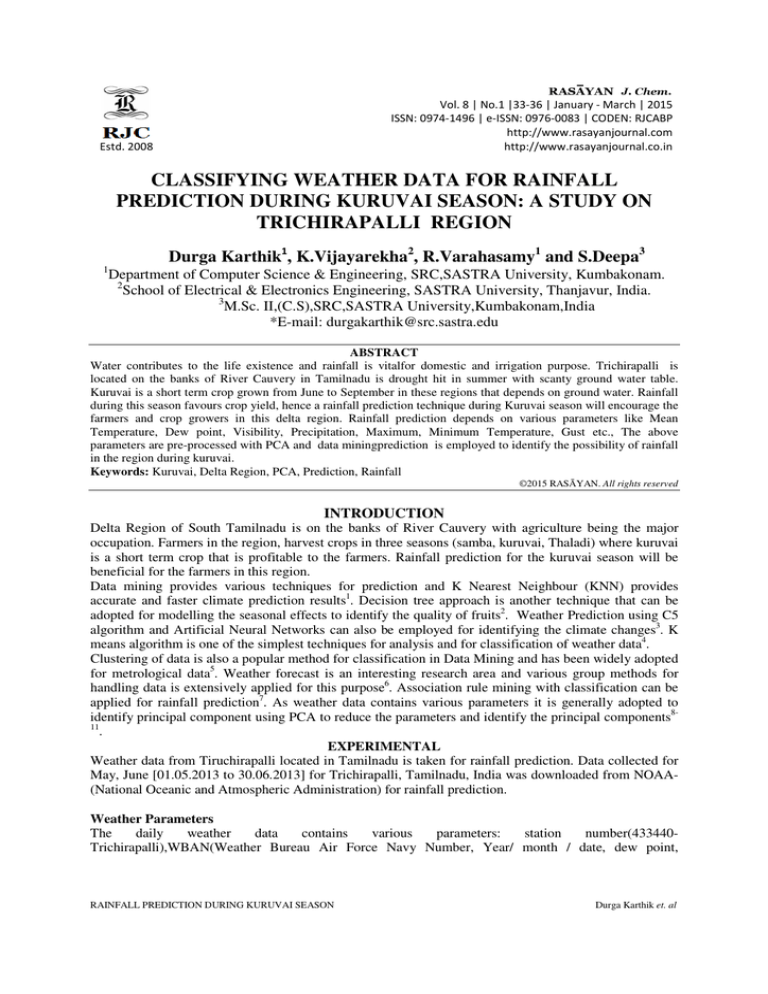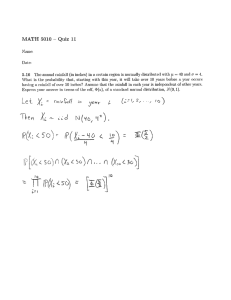
Vol. 8 | No.1 |33-36 | January - March | 2015
ISSN: 0974-1496 | e-ISSN: 0976-0083 | CODEN: RJCABP
http://www.rasayanjournal.com
http://www.rasayanjournal.co.in
Estd. 2008
CLASSIFYING WEATHER DATA FOR RAINFALL
PREDICTION DURING KURUVAI SEASON: A STUDY ON
TRICHIRAPALLI REGION
Durga Karthik1, K.Vijayarekha2, R.Varahasamy1 and S.Deepa3
1
Department of Computer Science & Engineering, SRC,SASTRA University, Kumbakonam.
2
School of Electrical & Electronics Engineering, SASTRA University, Thanjavur, India.
3
M.Sc. II,(C.S),SRC,SASTRA University,Kumbakonam,India
*E-mail: durgakarthik@src.sastra.edu
ABSTRACT
Water contributes to the life existence and rainfall is vitalfor domestic and irrigation purpose. Trichirapalli is
located on the banks of River Cauvery in Tamilnadu is drought hit in summer with scanty ground water table.
Kuruvai is a short term crop grown from June to September in these regions that depends on ground water. Rainfall
during this season favours crop yield, hence a rainfall prediction technique during Kuruvai season will encourage the
farmers and crop growers in this delta region. Rainfall prediction depends on various parameters like Mean
Temperature, Dew point, Visibility, Precipitation, Maximum, Minimum Temperature, Gust etc., The above
parameters are pre-processed with PCA and data miningprediction is employed to identify the possibility of rainfall
in the region during kuruvai.
Keywords: Kuruvai, Delta Region, PCA, Prediction, Rainfall
©2015 RASĀYAN. All rights reserved
INTRODUCTION
Delta Region of South Tamilnadu is on the banks of River Cauvery with agriculture being the major
occupation. Farmers in the region, harvest crops in three seasons (samba, kuruvai, Thaladi) where kuruvai
is a short term crop that is profitable to the farmers. Rainfall prediction for the kuruvai season will be
beneficial for the farmers in this region.
Data mining provides various techniques for prediction and K Nearest Neighbour (KNN) provides
accurate and faster climate prediction results1. Decision tree approach is another technique that can be
adopted for modelling the seasonal effects to identify the quality of fruits2. Weather Prediction using C5
algorithm and Artificial Neural Networks can also be employed for identifying the climate changes3. K
means algorithm is one of the simplest techniques for analysis and for classification of weather data4.
Clustering of data is also a popular method for classification in Data Mining and has been widely adopted
for metrological data5. Weather forecast is an interesting research area and various group methods for
handling data is extensively applied for this purpose6. Association rule mining with classification can be
applied for rainfall prediction7. As weather data contains various parameters it is generally adopted to
identify principal component using PCA to reduce the parameters and identify the principal components811
.
EXPERIMENTAL
Weather data from Tiruchirapalli located in Tamilnadu is taken for rainfall prediction. Data collected for
May, June [01.05.2013 to 30.06.2013] for Trichirapalli, Tamilnadu, India was downloaded from NOAA(National Oceanic and Atmospheric Administration) for rainfall prediction.
Weather Parameters
The
daily
weather
data
contains
various
parameters:
station
number(433440Trichirapalli),WBAN(Weather Bureau Air Force Navy Number, Year/ month / date, dew point,
RAINFALL PREDICTION DURING KURUVAI SEASON
Durga Karthik et. al
Vol. 8 | No.1 |33-36 | January - March | 2015
temperature, mean values for station level pressure , sea level pressure, wind speed ,visibility, and
sustained speed, maximum values for wind gust, maximum and minimum temperature, snow depth, total
precipitation, FRSHTT(fog, rainfall, snow, hail, thunder, tornado) indicator.
Preprocessing
The above parameters are required for a faster, reliable classification and prediction of rainfall. Nearly 15
parameters are present; hence it is required to pre-process the above parameters. PCA(Principal
component Analysis) was adopted to identify the principal parameters and to reduce the parameter for
better classification. The weather data was input to the SPSS tool and it identified 5 major parameters as
Temperature, Dew point, Precipitation, Wind speed, Visibility. The above principal parameter was
employed for rainfall prediction.
Rainfall prediction requires identifying the suitable conditions7 for the above parameters. The suitable
conditions for rainfall for the above parameters are given below in Table-1.
Table-1: Principal Parameters and suitable Conditions for Rainfall During Kuruvai
Principal Parameters
Favourable Condition
Temperature
(Fahrenheit)
>20
Dew point.
(Fahrenheit)
>75
Precipitation.
(Inches)
>0
Visibility
(Miles)
4 to 7
Wind speed
(Knots)
5.2 to 10.
The above conditions were used in a cluster program with (ASP.net and Sql server) using binary indicator
function for Trichirapalli weather data (May –June 2013). For the given dates, if the above condition is
satisfied, the value was set as 1 else it was set as 0. All the five parameter values were summed and based
on the summation value four clusters resulted. All the conditions were not satisfied, hence only 4 was the
maximum value, followed by 3, 2, 1. The four clusters based onsummation value was named as
Favourable (4), Moderately Favourable (3), Fairly Favourable (2) and Not Favourable (1) for rainfall.
One sample output with input date showing Favourable condition for rainfall using cluster program is
given in figure-1.
Fig.-1: Cluster Program output Showing Favourable Cluster for Rainfall in Trichirapalli
The program grouped all the data into one of the four clusters accordingly. The above data was again
subjected to EM classifier for authenticating the clusters formed from cluster program.
EM Classifier
The weather data was fed into WEKA EM classifier, an unsupervised classifier that too resulted in four
classifications as given in the following Figure-2.
The output graph for the above clusters using EM classifier is given below in figure-3.
Statistical Inference
The results obtained from cluster program using Binary indicator logic and EM cluster where compared
and the results were tested for significance of the classification using ANOVAs is given in Table-2.
RAINFALL PREDICTION DURING KURUVAI SEASON
34
Durga Karthik et. al
Vol. 8 | No.1 |33-36 | January - March | 2015
Fig.-2: EM cluster using WEKA showing four Clusters for Weather data
Table-2: Comparison of cluster results using Anova
Cluster/ Technique
Favourable
Moderately
Favourable
Fairly
Favourable
Not
Favourable
Cluster Pgm (Binary
Indicator Fn)
EM Clustering
5
2
22
23
25
31
9
5
Anova Between
groups (p=0.0023)
Fig.-3: Four clusters shown using WEKA EM Cluster.
The p value between groups using Anova is 0.0023 (p<0.05) which is less than 0.05; hence the above
classification is significant.
CONCLUSION
The Classification methods shows that weather data can be classified as favourable, moderate, fairly
favourable, not favourable for rainfall. The statistical results have proved that the classification formed by
the above technique can be accepted as (p<0.05).The above classification using Binary indicator based
RAINFALL PREDICTION DURING KURUVAI SEASON
35
Durga Karthik et. al
Vol. 8 | No.1 |33-36 | January - March | 2015
technique can be used to predict rainfall condition for kuruvai season. The work will be extended to
predict rainfall for other seasons also.
REFERENCES
1. Zahoor Jan, Abrar Muhammad, Bashir Shariq and Mirza Anwar M. ,Comm. Comp. Info. Sci., 20,
40 (2008)
2. Subana Shanmuganathan ,Philip Sallis and Ajith Narayanan, Second International Conference on
Computational Intelligence,Communication Systems and Networks, IEEE, pp.84-89(2010)
3. Folorunsho Olaiya and Adesesan Barnabas Adeyemo, Int. J. Infor. Eng. Electro. Bus., 1, 51(2012).
4. T.V. Rajinikanth, V.V.S.S.S. Balaram and N.Rajasekhar, InWes, (Dhinaharan Nagamalai et al.
(Eds)) pp.89-94, (2014). DOI : 10.5121/csit.2014.4510
5. Meghali A.Kalyankar and S.J.Alaspurkar, Int. J. Adv. Res. Comp. Sci. Soft. Eng., 3(2), 114(2013)
6. Godfrey C.Onwubolu, Petr Buryan, Sitaram Garimella, Visagaperuman Ramachandran, Viti
Buadromo and Ajith Abraham, IADIS European Conference Data Mining ,pp.81-88,(2007)
7. S. Meganathan, T.R. Sivaramakrishnan, Res. J. Appl. Sci., Eng. Tech., 5 (14), 3692( 2013.)
8. Durga Karthik and K. Vijaya Rekha, Res. J. Appl. Sci., Eng. Tech., 4 (24), 5357(2012)
9. R.Varahasamy, Rasayan J.Chem., 7(3), 264(2014)
10. Durga Karthik, K. Vijayarekha and Subramaniyan Sekar, Pol. J. Environ. Stud.,23(2) ,573(2014)
11. Durga Karthik and K.Vijayarekha , Rasayan J. Chem., 7(3) , 256( 2014)
[RJC-1218/2015]
RAINFALL PREDICTION DURING KURUVAI SEASON
36
Durga Karthik et. al


